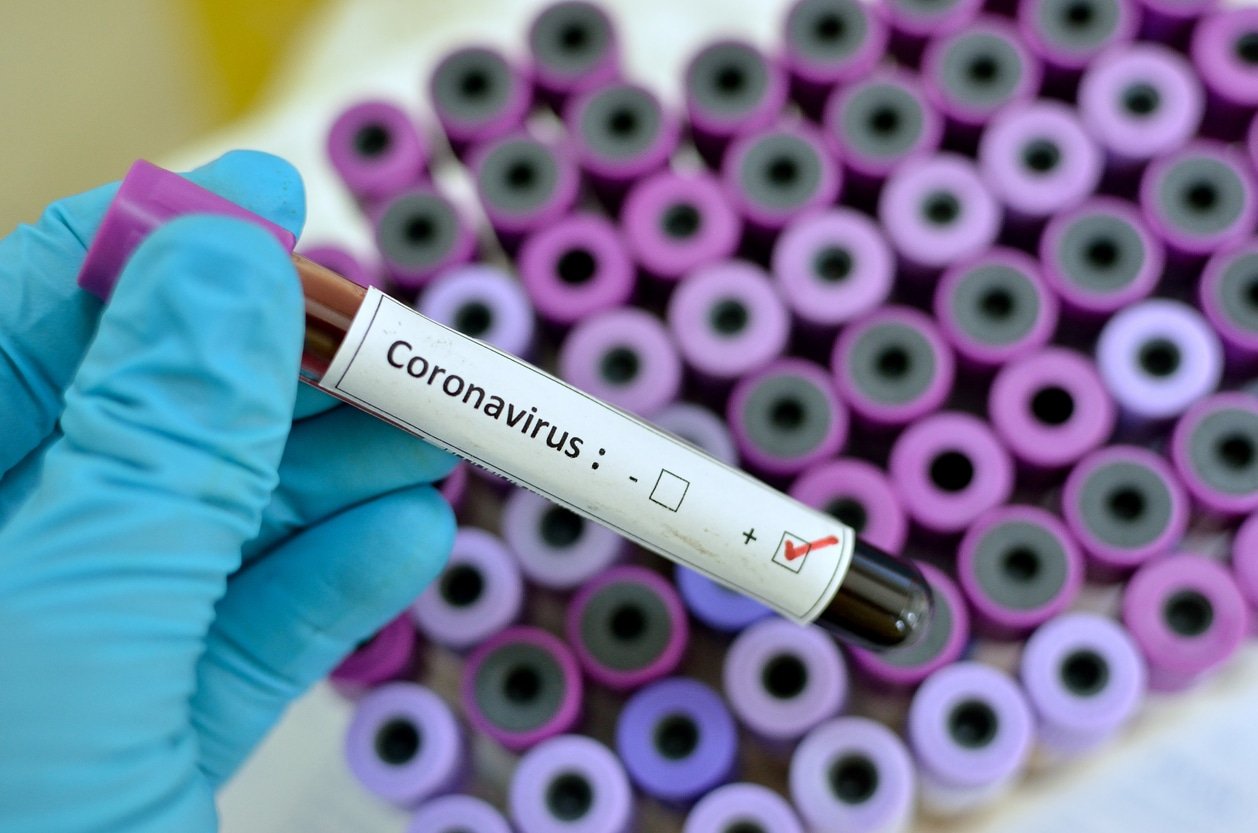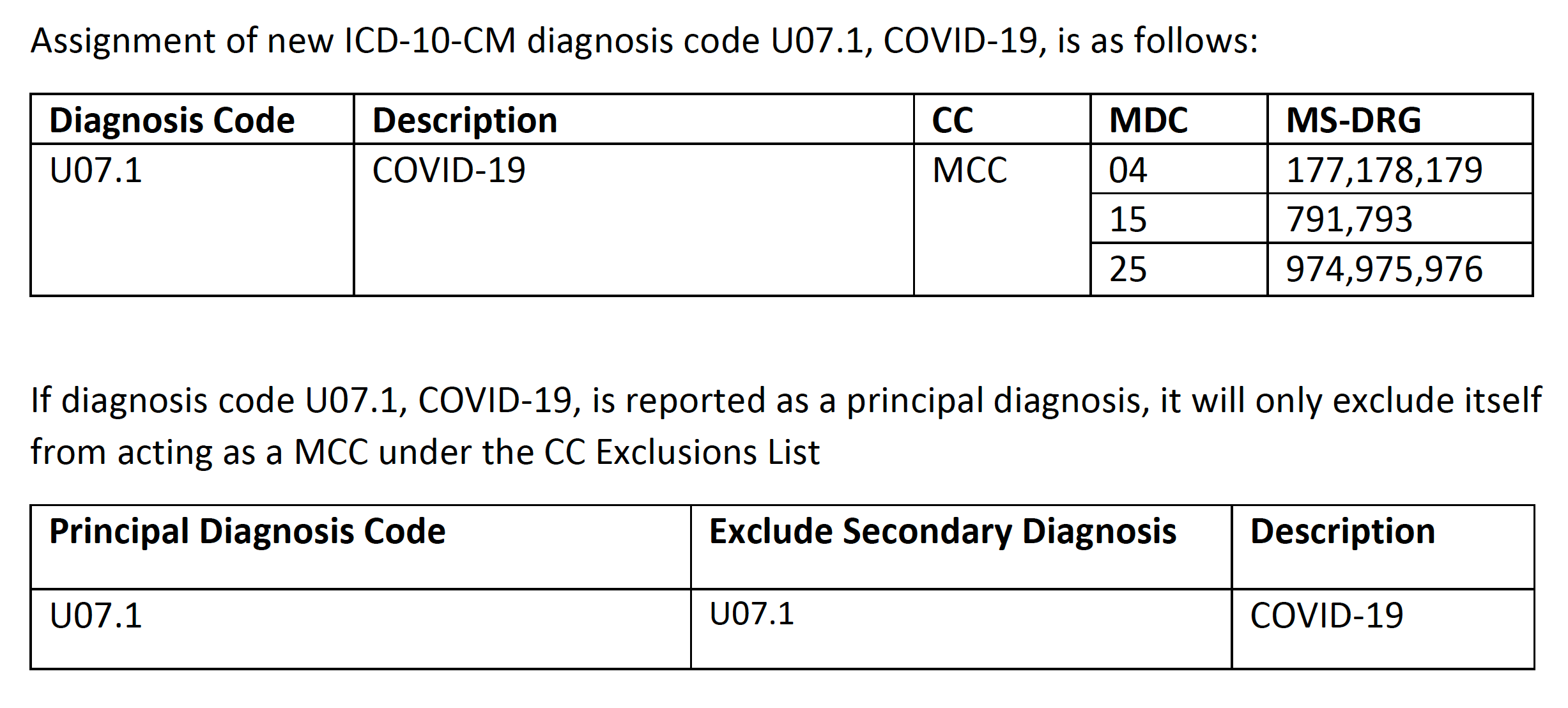CAUTION: The below applies for discharges of APRIL 1, 2020 OR AFTER
Acute respiratory illness due to COVID-19:
Pneumonia
For a pneumonia case confirmed as due to the 2019 novel coronavirus (COVID-19), assign codes U07.1, COVID-19, and J12.89, Other viral pneumonia.
Acute bronchitis
For a patient with acute bronchitis confirmed as due to COVID-19, assign codes U07.1, and J20.8, Acute bronchitis due to other specified organisms. Bronchitis not otherwise specified (NOS) due to COVID-19 should be coded using code U07.1 and J40, Bronchitis, not specified as acute or chronic.
Lower respiratory infection
If the COVID-19 is documented as being associated with a lower respiratory infection, not otherwise specified (NOS), or an acute respiratory infection, NOS, codes U07.1 and J22, Unspecified acute lower respiratory infection, should be assigned. If the COVID-19 is documented as being associated with a respiratory infection, NOS, codes U07.1 and J98.8, Other specified respiratory disorders, should be assigned.
Acute respiratory distress syndrome
For acute respiratory distress syndrome (ARDS) due to COVID-19, assign codes U07.1, and J80, Acute respiratory distress syndrome.
Coders are advised to review the FAQs on COVID-19 coding beginning April 1, 2020. This site will be updated by AHA as necessary:
https://www.aha.org/fact-sheets/2020-03-30-frequently-asked-questions-regarding-icd-10-cm-coding-covid-19
https://www.aha.org/system/files/media/file/2020/03/Frequently-Asked-Questions-Regarding-COVID-19_v3.pdf
The below was a FAQ on AHA regarding sequencing of COVID-19 and Sepsis:
Question: Since the new guidelines for COVID regarding sepsis just say to refer to the sepsis guideline, is that then saying that sepsis would be sequenced first and then U07.1 for a patient presenting with sepsis due to COVID-19? (4/1/2020)
Answer: Whether or not sepsis or U07.1 is assigned as the principal diagnosis depends on the circumstances of admission and whether sepsis meets the definition of principal diagnosis. For example, if a patient is admitted with pneumonia due to COVID-19 which then progresses to viral sepsis (not present on admission), the principal diagnosis is U07.1, COVID-19, followed by the codes for the viral sepsis and viral pneumonia. On the other hand, if a patient is admitted with sepsis due to COVID-19 pneumonia and the sepsis meets the definition of principal diagnosis, then the code for viral sepsis (A41.89) should be assigned as principal diagnosis followed by codes U07.1 and J12.89, as secondary diagnoses.
More: https://www.codingclinicadvisor.com/faqs-icd-10-cm-coding-covid-19
DRGs that will be assigned for COVID-19 code as of April 1, 2020:
More info:
https://www.cdc.gov/nchs/icd/icd10cm.htm
https://www.cdc.gov/nchs/data/icd/Announcement-New-ICD-code-for-coronavirus-3-18-2020.pdf
We will continue to keep our readers updated as new information is released.
From the CDC news release:
On March 11, 2020 the Novel Coronavirus Disease, COVID-19, was declared a pandemic by the World Health Organization. On March 13, 2020 a national emergency was declared in the United States concerning the COVID-19 Outbreak. Given these developments, and the urgent need to capture the reporting of this condition in our nation’s claims and surveillance data, the Centers for Disease Control (CDC), under the National Emergencies Act Section 201 and 301, is announcing a change in the effective date of new diagnosis code U07.1, COVID-19, from October 1, 2020 to April 1, 2020. This off-cycle update is unprecedented and is an exception to the code set updating process established under HIPAA.
CAUTION: The below applies for discharges BEFORE APRIL 1, 2020
The Centers for Disease Control and Prevention (CDC) has developed a new code for the COVID-19 (coronavirus).
A new International Classification of Diseases, Tenth Revision (ICD-10) emergency code (U07.1, 2019-nCoV acute respiratory disease) has been established by the World Health Organization (WHO).
The new code U07.1 IS NOT RETROACTIVE
Until this code goes into effect, the CDC has provided advice on coding the COVID-19 coronavirus:
Pneumonia
For a pneumonia case confirmed as due to the 2019 novel coronavirus (COVID-19), assign codes J12.89, Other viral pneumonia, and B97.29, Other coronavirus as the cause of diseases classified elsewhere.
Acute Bronchitis
For a patient with acute bronchitis confirmed as due to COVID-19, assign codes J20.8, Acute bronchitis due to other specified organisms, and B97.29, Other coronavirus as the cause of diseases classified elsewhere. Bronchitis not otherwise specified (NOS) due to the COVID-19 should be coded using code J40, Bronchitis, not specified as acute or chronic; along with code B97.29, Other coronavirus as the cause of diseases classified elsewhere.
Lower Respiratory Infection
If the COVID-19 is documented as being associated with a lower respiratory infection, not otherwise specified (NOS), or an acute respiratory infection, NOS, this should be assigned with code J22, Unspecified acute lower respiratory infection, with code B97.29, Other coronavirus as the cause of diseases classified elsewhere. If the COVID-19 is documented as being associated with a respiratory infection, NOS, it would be appropriate to assign code J98.8, Other specified respiratory disorders, with code B97.29, Other coronavirus as the cause of diseases classified elsewhere.
ARDS
Acute respiratory distress syndrome (ARDS) may develop in with the COVID-19, according to the Interim Clinical Guidance for Management of Patients with Confirmed 2019 Novel Coronavirus (COVID-19) Infection.
https://www.cdc.gov/coronavirus/2019-ncov/hcp/clinical-guidance-management-patients.html
Cases with ARDS due to COVID-19 should be assigned the codes J80, Acute respiratory distress syndrome, and B97.29, Other coronavirus as the cause of diseases classified elsewhere.
Exposure to COVID-19
For cases where there is a concern about a possible exposure to COVID-19, but this is ruled out after evaluation, it would be appropriate to assign the code Z03.818, Encounter for observation for suspected exposure to other biological agents ruled out. For cases where there is an actual exposure to someone who is confirmed to have COVID-19, it would be appropriate to assign the code Z20.828, Contact with and (suspected) exposure to other viral communicable diseases.
Signs and symptoms
For patients presenting with any signs/symptoms (such as fever, etc.) and where a definitive diagnosis has not been established, assign the appropriate code(s) for each of the presenting signs and symptoms such as:
- R05 Cough
- R06.02 Shortness of breath
- R50.9 Fever, unspecified
Note: Diagnosis code B34.2, Coronavirus infection, unspecified, would in generally not be appropriate for the COVID-19, because the cases have universally been respiratory in nature, so the site would not be “unspecified.”
For more information, and to stay up-to-date on this evolving pandemic, visit the sites below:
https://www.cdc.gov/coronavirus/2019-ncov/index.html






Leave a Comment